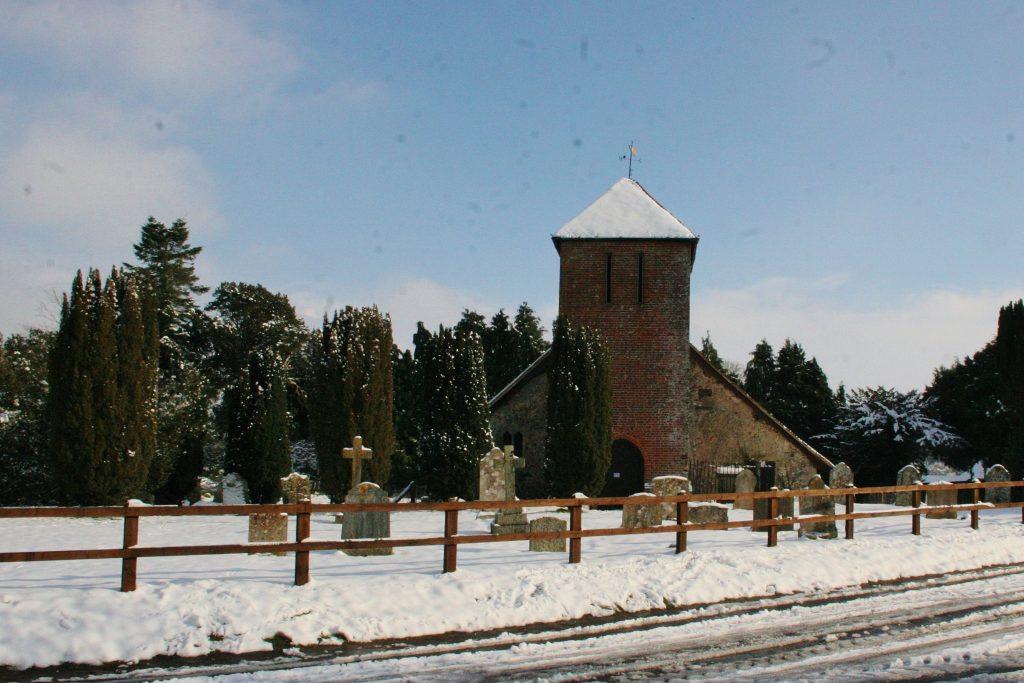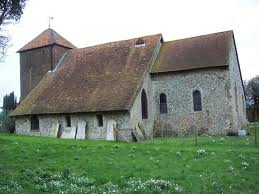
A HISTORY OF ST.JOHN’S CHURCH
West Grimstead is an ancient parish, the name “Grimstead” originating from the Old English word Grenehamstede (green homestead). It is mentioned in the Doomsday Book, with the information that there was a mill here. Its population has varied little during the past 150 years remaining around the 200 mark until developments about 40 years ago when a small estate was built and old cottages demolished to make space for an increased number of dwellings. New houses continue to be built, but the adult population remains less than 350. The Church and the Village Hall opposite are the focal points for activities in the village. There is also a Methodist Church where weekly services are held.
The exact date of the building of the church is unknown, it was certainly in existence before 1150, and tradition has it that it was built in the reign of William Rufus (1087 – 1100). The dedication to “St.John” does not make it clear whether this is St.John the Baptist or St.John the Apostle and Evangelist.
The first recorded Rector was Ricardus Brione, 1294. In the absence of a certain date for the building of the church we celebrated in 1994, 700 years since the appointment of the first Rector, as, St.John the Baptists Day falls on 24th June we chose this as the date on which to base a week long festival of events.
There are some interesting architectural features in the church. The two pillars and arches to the north of the nave are 14th Century and have alternate red and white construction of Chilmark and brown heathstone.
The 14th Century East window was inserted with three trefoil headed lights and a cinquefoiled rear arch forming a canopy. An unusual construction. The only other original windows are those in the North and West walls of the North aisle which both have two lights with trefoiled heads and are typical of the 15th Century. The stained glass in the East window is early 20th Century and that in the East window of the South aisle was commissioned to commemorate the 1994, 700th Anniversary celebrations.
The main roof beams are 14th Century made of Spanish chestnut which is resistant to disease. Unfortunately this does not apply to the other timbers and in the year 2000 a massive repair and restoration job had to be carried out.
Whilst the church has been altered through the centuries it escaped the massive and insensitive restoration suffered by so many churches in Victorian times, although unfortunately the interior walls were covered by a thick layer of very hard, grey concrete giving a gloomy look to the church. In 1992 these walls were painted with white oil bound distemper which, together with new lighting and other improvements turned the church into a lighter, more welcoming place.
The beautiful carved pulpit is probably Jacobean but may be late Elizabethan. The frame of the Communion table is also 17th Century but the top of a later date. The bowl of the font is Norman but set on a 19th Century base. There is an 18th Century lectern with a swivel desk top though the lectern in current use is a late 19th or early 20th Century In the vestry is an old altar table reputed to be Tudor. Also on the wall of the vestry is a grotesque beasts head, probably brought to the church from elsewhere, it may well be a “Sheila-na-gig” a pagan fertility symbol, though what it is doing in a Christian church is unclear, but there are others scattered in churches through the country.
In the middle of the nave is a large slab, in the centre of which was formerly a small brass figure of a woman in a pointed head dress. (No doubt the brass was removed in Cromwellian times) The Latin inscription around the edge of the slab is difficult to decipher but enough can be read to show the stone commemorates Alicia, daughter of Sir John Lye of the Isle of Wight who was the wife of John Mompesson of Bathampton.
There is a painted panel bearing the Royal Arms and the Arms and Motto of Queen Anne. How and why this came to the church is not known.
In the early 18th Century a brick built tower was added at the West end, replacing a wooden belfry. This houses 2 bells the earliest of which was installed in 1712 with an inscription which reads “J.T.and S.E.churchwardens cast me”. The second bell was added in 1815 and is inscribed “James Wells, Aldbourne, Wilts fecit 1815”
When the tower was built the doors which had been set in the north and south walls (opposite each other to allow the devil to fly right through the church and out the other side) were blocked and windows inserted.
The church registers and other documents are kept in an iron chest in the vestry which was made at Bramshaw in the New Forest in 1813. The ancient registers dating from 1717 have, in accordance with the law, been lodged at the County Archives in Trowbridge to avoid deterioration. Record Books dating from the early 19th Century were in use until their removal to County Archives in 1983.
In Edward Hutton’s “Highways and Byways of Wiltshire” are these words: At West Grimstead there is a little old church, very reverent and homely and still. The whole humble building is worth a close and loving inspection and is a delight on a lonely road”
Unfortunately our insurers insist that the church be kept locked, therefore if you would like to visit, please ring Mr Malcolm Read, Churchwarden, on 710302 who will be very pleased to show you around.
More detailed information on the architecture of the church is contained in the book “Churches of South-East Wiltshire” compiled by the Royal Commission on the Historical Monuments of England, and published by H.M.S.O.IN 1987.
From the mid 19th Century there was a church school in West Grimstead. Unfortunately the original building was very small, only one room, without water laid on or toilets. This to accommodate all school age children from 5 to 14… After World War II two mobile buildings were erected behind the Village Playing Field opposite and these contained three classrooms, toilets, and the head teacher and secretary shared a minute office situated between two classrooms. The original building continued to be used for physical activities and school meals (brought in from outside).
The conditions were totally inadequate for present day educational needs and the physical condition of the buildings left much to be desired. Also the number of children of primary school age in the village decreased and numbers were only kept up by a large number coming from Whaddon, the village adjoining Alderbury.
Finally it was regretfully decided that as both West Grimstead and Alderbury schools were sub-standard, a new church school for the two villages would be built at Alderbury. This decision was not reached without a great deal of soul searching and the loss of our school was, and still is, mourned. However, the church and local authorities were instrumental in building a school at Alderbury to an imaginative design, with much better facilities and good play grounds and playing fields. It is a hugely successful school with high standards and already an extra classroom has had to be built on. Fortunately the design of the school allowed for this to be done so obviating the need to bring in “mobiles”.
The alternative to this new school would have been “bussing” primary age school children into Salisbury, as the schools would have been closed in any case.
St.John’s Church is a member of THE CLARENDON TEAM comprising eight churches – Alderbury, East Grimstead, Farley Pitton, West Dean, West Grimstead, Whiteparish and Winterslow..
From time to time there are changes in times and types of service – these can be found in the Village Magazines “The Fountain” and “Village Life.
PAROCHIAL CHURCH COUNCIL consists of: Two Churchwardens, Secretary, Treasurer, Electoral Roll Officer, 4 others.
Church members take full responsibility for the care of the church- there is a cleaning and flower arranging rota, a grass mowing rota for the churchyard and all routine work is carried out by a member of the congregation. As church members assist in many ways in the village, so non-church goers assist in these duties. Volunteers are always welcome.
MAGAZINES There are two Magazines. “THE FOUNTAIN” is a magazine for the Villages of Alderbury, West Grimstead and Clarendon. It is published monthly and costs £2 per year.
The other is “THE VILLAGE LIFE” for West Grimstead only; it not only contains news of events but articles on gardening, nature, and other items of general interest. This is paid for by advertisements and is distributed free to every home in the village. Both magazines are delivered by volunteers from the church congregation.……
Church members play a full role in village life; there are two official representatives on the Village Hall Committee. Other members of the Committee are also church members and whenever there are functions organised by the hall a large proportion of the helpers also belong to the church.
It is very unusual for there not to be church members on the Parish Council.
Being a small village it is easy for us to hear of people who are ill or in trouble and they are visited by clergy and lay members of the congregation unless they indicate this would be unacceptable – a rare event!
Whenever newcomers move into the village they are visited and welcomed by members of the congregation and given an information leaflet about the village, also copies of The Fountain, and The Village Life.
A WARM WELCOME AWAITS ALL WHO COME TO THE CHURCH FOR WHATEVER REASON
…………………….
Link:- http://www.clarendonteam.org/west%20grimstead.html

